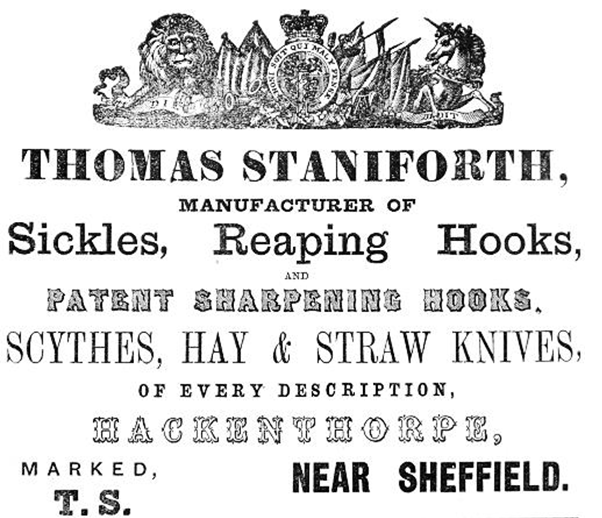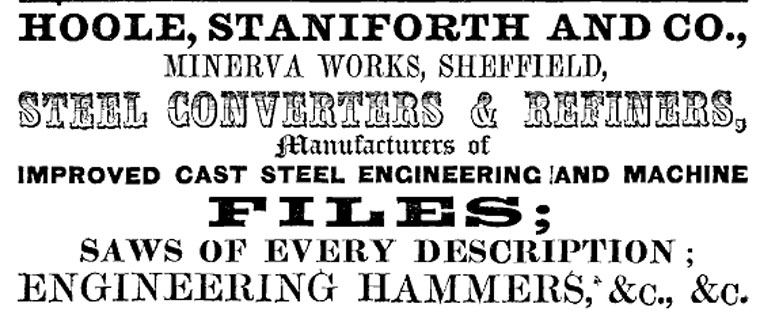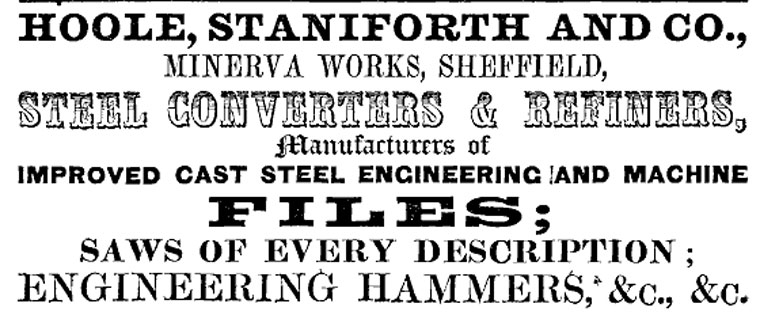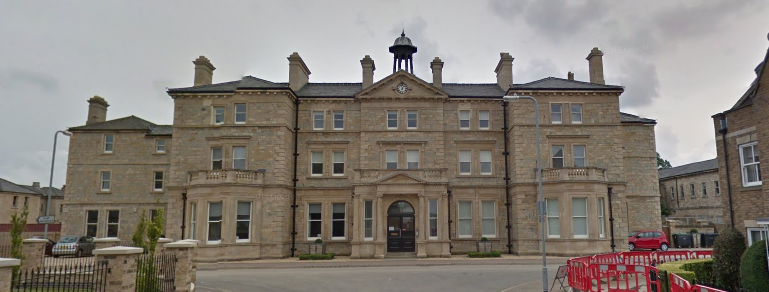
Thomas Staniforth & Co. Sickle works at Hackenthorpe.
 Rowland Staniforth was baptised at Beighton on March 26th 1818. He was the son of Hackenthorpe Sicklesmith Thomas Staniforth III and his wife Ann (nee Hibbard). His father was the grandson of Thomas Staniforth, a well-regarded sickle manufacturer who established the family Sickle and Scythe smithing business in 1753.
Rowland Staniforth was baptised at Beighton on March 26th 1818. He was the son of Hackenthorpe Sicklesmith Thomas Staniforth III and his wife Ann (nee Hibbard). His father was the grandson of Thomas Staniforth, a well-regarded sickle manufacturer who established the family Sickle and Scythe smithing business in 1753.
Little is known regarding Rowlands early life, it is very likely that he grew up apprenticed to his father, however there is no record backing this up.
In the Sheffield Independent, dated the 4th of January 1845, it is reported that Mr Rowland Staniforth of Western Bank married Louisa, daughter of Mr. B. Schofield of Broom Hill. Rev. Thomas Mountain of Beighton marries them at the Parish Church and the marriage took place the previous Thursday which would have been January 2nd.
Rowland is also listed in various directories in 1848, including the Institution of Mechanical Engineers, under New Members, he is also listed as working at the Minerva Steel Works in Sheffield. It is around this time that Rowland goes into partnership with Henry Poole and James Gray, they form the firm Hoole, Staniforth and Gray.
Charles Linley, a cabman, in the employ of Mr. Peter Collis, was charged under the bye-laws with refusing to take a fare when on the stand. At nine o’clock on Sunday, Mr. Rowland Staniforth, of the firm of Hoole, Staniforth, and Gray, sent a message to one of the cab-stands to engage a cab to take him to his residence, on the Glossop Road, at half-past ten o’clock. It was just after nine o’clock when the messenger was at the stand. Linley was the first man he saw, and he gave him the order. Linley was exceedingly insolent, and refused to attend, saying that Mr. Staniforth had engaged Thompson’s in the morning to take him to Hackenthorpe, and he must go to Thompson to take him home….Linley’s defense was that his master had ordered him to be at home with his cab at nine o’clock; and as Thompson, who had been hired by Mr. Staniforth in the morning, was then on the stand, he thought they ought rather to go to Thompson, than keep him on the stand for an hour and a half…. Mr. Raynor said the regulations under which the cab proprietors were allowed to have places on the stand required that they should take any job offered them up to twelve o’clock…. Mr. Broomhead, Jun, solicitor, said he had been frequently annoyed by cab drivers acting in the same way as Linley had towards Mr. Staniforth…. Mr. Wilkinson said it was evident that the defendant’s story as to his master having ordered him to be home with his horse at nine o’clock had not been his reason for refusing the fare, as it was after nine when the message found him on the stand. He fined him 5s and 4s costs’ On the 23rd of September 1848, Rowland is mentioned as being in attendance of the North Derbyshire Agricultural Society show and dinner. The show was held at ‘Edensor, within the domain of his grace the Duke of Devonshire, the great patron and supporter of the society’ ‘Among the gentleman on the ground were… Rowland Staniforth, Esq’ It seems that in 1850, Henry Hoole and Rowland parter ways with James Gray, in the London Gazette dated April 1st, 1850, there is an etry for March 12th ‘Henry Hoole, Rowland Staniforth and James Gray, Sheffield merchants and steel and file manufacturers so far as regards James Gray, debts received and paid by the remaining partners’ This is further verified as an 1852 director of Sheffield simply describes:
Rowland Staniforth, file manfr (Hoole, Staniforth and Co) House Lowfield. There is also an auction listed in the Derbyshire Courier on March 2nd 1850:
‘The Four commodious, well-built and highly finished dwelling house at Lowfield, about a mile from the Parish Church of Sheffield, on the Chesterfield Road, being commonly called Lowfield Terrace, with the garden, ornamental ground, and privileges attached to each of such dwelling houses, as the same are now in the several occupations of Mrs. Schofield, Miss Smith, Mrs. Mason and Rowland Staniforth, Esq. The site of the above premises contains 1a, 1r and 17R of Land, and is leasehold, being held for a term of 488 years, commencing 25th March 1810 at the yearly ground-rent of £ 25 14s 2d. On July 5th 1851 Sheffield Independent, the ‘usual monthly meeting of the improvement commissioners was held on Wednesday forenoon, when the Mayor took the chair’ Rowland Staniforth is mentioned as a non-attendee. Finally in February 1853 we see mentions of Rowlands death:
‘Staniforth – On the 6th instance, after a long and severe affliction, Mr. Rowland Staniforth, of Sheffield, merchant and manufacturer, in the 35th year of his age.’ Another newspaper gives the following account
‘On Sunday last, in the asylum, Lincoln, Mr. Rowland Staniforth, late of Sheffield, aged 34’ The official date of death is February 5th 1853, it is unclear as to why Rowland was sent to the Asylum, or what exactly transpired between 1852 when Rowland is still listed at the house at Lowfield, and the start of 1853 where he was placed in the Asylum after suffering a ‘long and severe affliction’. Finally on September 7th 1853 it is announced in the London Gazette that the Partnership between Henry Hoole and Rowland Staniforth (deceased) is dissolved. Although Rowland only had a short life, only living to be 34 years of age, it is clear he lived a full life, and seems to have been a notable tool maker in Sheffield. On March 4th, 1848 a peculiar story was featured in the Sheffield Independent:
On March 4th, 1848 a peculiar story was featured in the Sheffield Independent:
